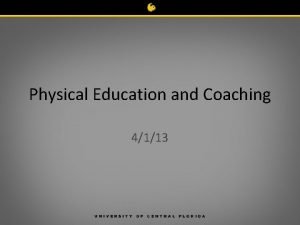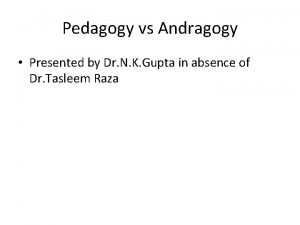FACULTY OF EDUCATION Department of Curriculum and Pedagogy














- Slides: 14

FACULTY OF EDUCATION Department of Curriculum and Pedagogy Physics Dynamics: Friction Science and Mathematics Education Research Group Supported by UBC Teaching and Learning Enhancement Fund 2012 -2013

Properties of Friction Question Title ffric F

Static vs. Kinetic Question Title Friction I A block is resting on a rough table. The maximum frictional force between the block and the table is 10 N when the block is stationary, and 5 N when the block is moving. You begin pushing the block with a slowly increasing force F from 0 N to 15 N. Which correctly describes the magnitude of the friction force for the given values of F? F ffric F 0 N 5 N 10 N 15 N A. ffric 0 N 5 N 10 N 5 N B. ffric 0 N 5 N 10 N C. ffric 5 N 5 N D. ffric 10 N 5 N E. ffric 10 N

Solution Comments Answer: A Justification: When the block is stationary, a force less than 10 N will not cause the block to move because of the static friction force that ranges from 0 N to 10 N. As long as the block is stationary, the static friction must be equal and opposite to the applied force. As soon as the block begins moving (after a force larger than 10 N is applied), the frictional force will decrease to 5 N as it will become a force of kinetic friction.

Static vs. Kinetic Question Title Friction II Consider the same block and table as last question. After you finish pushing the block with a force increasing from 0 N to 15 N, you begin slowly decreasing the force from 15 N to 4 N. Which correctly describes the magnitude of the friction force for the given values of F? F ffric F 15 N 10 N 5 N 4 N A. ffric 5 N 5 N 5 N 0 N B. ffric 5 N 5 N 5 N 4 N C. ffric 5 N 5 N D. ffric 5 N 5 N 5 N 10 N E. ffric 5 N 5 N 10 N

Solution Comments Answer: C Justification: When you are pushing the block with the force of 15 N, it is accelerating since 15 N is larger than the force of kinetic friction (5 N), and the net force is greater than zero. When you start decreasing the force from 15 N to 5 N, the block will continue moving, but its acceleration will start decreasing. When the applied force reaches 5 N, it becomes equal to the friction force, causing the block to stop accelerating and start moving at a constant speed. When the applied force becomes less than kinetic friction force, the block starts slowing down. Since it is still moving, the friction force will remain the kinetic friction force of 5 N.

Friction III Title Question Four 5 kg blocks are kicked across a rough table at different initial velocities. Which of the blocks shown below is slowing down the fastest due to friction? Ignore air resistance. A. ffric C. ffric 5 kg 1 m/s B. ffric 3 m/s D. ffric 5 kg 2 m/s 4 m/s E. All 4 blocks are slowing down at the same rate

Solution Comments Answer: E Justification: Each block experiences the same friction force of: In this case, the friction force is equal to the net force acting on the block, so it determines its acceleration. Since the friction force does not depend on velocity, all 4 blocks will have the same acceleration no matter its initial velocity (besides 0 m/s – then it is not moving). Unlike air resistance, the force of friction does not depend on the speed of the object.

Friction IVTitle Question Consider a 5 kg block sliding on a rough table at 5 m/s at t = 0 s. The block comes to a stop at t = 5 s due to friction. At what time is the friction force the largest? Ignore air resistance. t=0 s t=5 s ffric 5 kg 5 m/s 5 kg stationary block A. t = 0 s B. t = 2. 5 s C. t = 5 s (when the block is stationary) D. The friction force is the same at all times (until the block stops moving) E. The friction force at any particular time cannot be determined.

Solution Comments Answer: D Justification: The friction force is the same at all times when the block is sliding. The block experiences the constant friction force of: In the equation above, uk, m and g are all constant with respect to time so the friction force is constant at all times. Recall that in the last question that the velocity of the block also does not change the friction force.

Friction V Title Question Blocks with various mass are sliding on a rough surface with an initial velocity of 5 m/s. Assume ffric = μk. FN, μk = 0. 5, g = 10 m/s 2. Which block will come to a stop first? A. C. ffric 3 kg 7 kg 5 m/s B. 5 m/s D. ffric 5 kg 9 kg E. All blocks will stop at the same time. 5 m/s

Solution Comments Answer: E Justification: Each block experiences a friction force of: The friction force is equal to the net force acting on the block, so it determines the acceleration of the block. The acceleration of the block does not depend on mass, therefore all the blocks will stop at the same time. Even though there is a larger friction force for a massive object, it is also harder to change the velocity of a massive object.

Friction VITitle Question Alex and Heather are moving a giant box across the floor at constant velocity. Alex pulls the box by applying a force upwards at 45° (assume the block is heavy enough so that it does not lift off the ground). Heather, on the other hand, decides to push the box by applying a force downwards at 45°. Who must apply the greater force to keep the box moving at a constant velocity? A. Fpull B. Fpush 45° ffric Alex Heather C. Alex and Heather apply the same force

Solution Comments Answer: B Justification: When Heather pushes downwards on the box, there is a greater normal force between the ground and the box. The greater normal force means there is a greater friction force, and Heather must be pushing harder in order to oppose this greater force. Since Alex is pulling upwards, there is a smaller normal force and thus a smaller friction force.
 Education scotland play pedagogy toolkit
Education scotland play pedagogy toolkit Gde curriculum
Gde curriculum Nit calicut chemistry
Nit calicut chemistry Georgia tapp program
Georgia tapp program Sports pedagogy definition
Sports pedagogy definition Advanced pedagogy and application of ict
Advanced pedagogy and application of ict Epistemology and pedagogy
Epistemology and pedagogy Importance of faculty in higher education
Importance of faculty in higher education Faculty of education york university
Faculty of education york university Feri maribor
Feri maribor Chronicle of higher education salaries
Chronicle of higher education salaries Faculty of education khon kaen university
Faculty of education khon kaen university Techno pedagogy
Techno pedagogy Public pedagogy definition
Public pedagogy definition Pedagogy vs androgogy
Pedagogy vs androgogy



























